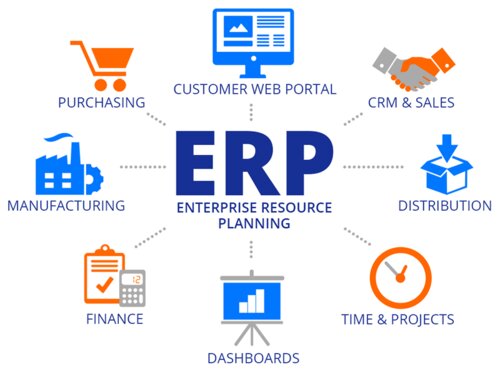
What is an ERP System?
ERP is an acronym for enterprise resource planning, a business management software. In an article produced for the CIO and business technology executive news website, CIO.com, contributing columnist Bart Perkins provides a comprehensive definition of an ERP system. He defines it as a “system of integrated software applications that standardizes, streamlines, and integrates business processes across finance, human resources, procurement, distribution, and other departments The American multinational computer technology corporation, Oracle, defines ERP as “a type of software that organizations use to manage day-to-day business activities, such as accounting, procurement, project management, risk management and compliance, and supply chain operations.” Oracle adds that for an ERP suite to be defined as complete, it needs to include software that assists organizations with planning, enterprise performance management, budgeting, forecasting, and creating reports with details of an organization’s financial results. ERP systems can also be extended with third-party applications to access features such as product life cycle management, e-procurement, product data management, data mining, and other such functions. The ERP system is usually extended through vendor-supplied interfaces.
How Does an ERP System Work?
An ERP system works by decreasing the number of resources needed to run the business optimally but still ensuring profitability and business improvement. The ERP system is different from a single application because it allows other enterprise modules of your company to work from one database. The system collects data from different parts of the business. It puts the data into a central location where employees who need it can access it. It dismantles the silos that many businesses suffer from and ensures that adequate information is available to those who need it. Suppose your company’s ERP system is almost fully automated. ERP does the data entry for you in the back-end and also exchanges the information with other units that need it. For instance, when a shipment order is initiated for the last item in stock, the inventory management modules must record this information and inform relevant departments so that the inventory can be replenished. The sales team will also be informed so that it doesn’t make promises that it can’t deliver.
Why Might You Need an ERP System?
- Sharing Information:
- Improved Business Performance:
- Easy to Manage:
- Reduced Costs:
The ERP system can automatically share crucial information across the various departments of your enterprise, and, as a result, it fosters collaboration through integrated information sharing.
The integrated system will ensure that departments spend time managing their core business instead of trying to get the information that would help them to do so. For instance, an ERP system could improve your business’s performance in sales forecasting through order tracking, revenue tracking, and purchase order generation.
With the rapid growth in technology, ERP systems continue to become easier to manage and use. This is especially the case for enterprises that may not have the skills or resources to integrate their systems. For large enterprises, ERP can reduce the resources required to run disjointed systems. Standardized Reporting: If you want your organization to communicate to the market, you will need everybody in the organization to be reading from the same book. ERP will ensure that the information delivered by your organization is coherent.
According to the Business Automation Specialists, a provider of ERP, accounting, and automation solutions, “Manufacturing companies with the best-in-class practices utilizing ERP systems were able to reduce inventory levels by 22%.” It adds, “Those same companies also saw almost a 20% reduction in overall costs.”
